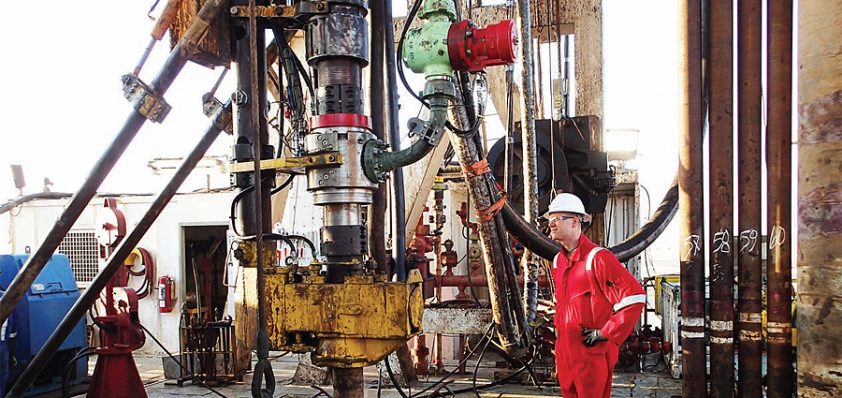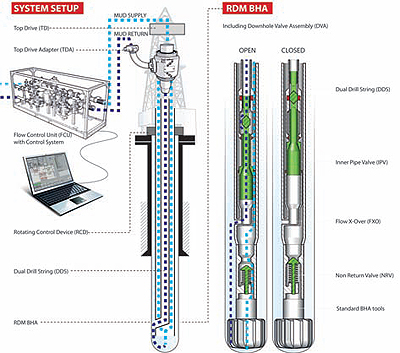
Reelwell
Extending innovation
Since the company was founded in 2004 Reelwell AS has continued to develop and promote its pioneering Reelwell Drilling Method (RDM) system and today has reached an important ten-year milestone in operation.
From its base in Stavanger Reelwell unveiled its RDM technology that would introduce new concepts that would challenge the traditional principles of Managed Pressure Drilling (MPD) and Extended Reach Drilling (ERD). RDM employs a revolutionary technique that uses accurate pressure management and superior well control through closed loop fluid circulation to push the limits of what had previously been thought possible. Indeed in terms of application, operators are able to use RDM to access reservoirs considered extremely challenging or even impossible to drill conventionally.
The RDM is based on the use of a Dual Drill String (DDS) in which drilling fluid flows to the drill bit via the drill string annulus, while the return flow to the surface is through an inner string. This is achieved through the use of a Top Drive Adapter (TDA), which is a dual conduit swivel that allows rotation of the drill string with the top drive. Furthermore, the TDA routes drilling fluid from the top drive to the DDS annulus before the return flow is taken out via the TDA housing.
Further downhole the Dual Float Valve (DFV) features double barriers on both channels and facilitates controlled pressure drilling and pressureless pipe connections. Redundancy can be achieved  through mounting two or more DFV units in series. The RDM is regulated through the Flow Control Unit (FCU), a control valve arrangement through which all active drill fluid is routed. The FCU assures constant downhole pressure during drilling and pipeline connection, and the unit is equipped with pressure and flow sensors on both the drilling fluid inlet and return lines. Furthermore the Reelwell control panel is fully integrated with the well control and monitoring system of the drilling facility. The result of the process is that drilling fluid is pumped into the DDS annulus via the TDA and down to the DFV at the top of a conventional Bottom Hole Assembly (BHA). From the DFV cuttings are transported back to the surface inside the inner string ensuring that the hole remains clean at all times.
through mounting two or more DFV units in series. The RDM is regulated through the Flow Control Unit (FCU), a control valve arrangement through which all active drill fluid is routed. The FCU assures constant downhole pressure during drilling and pipeline connection, and the unit is equipped with pressure and flow sensors on both the drilling fluid inlet and return lines. Furthermore the Reelwell control panel is fully integrated with the well control and monitoring system of the drilling facility. The result of the process is that drilling fluid is pumped into the DDS annulus via the TDA and down to the DFV at the top of a conventional Bottom Hole Assembly (BHA). From the DFV cuttings are transported back to the surface inside the inner string ensuring that the hole remains clean at all times.
Reelwell was last featured in European Oil & Gas Magazine during November 2011, at which time sales and marketing manager Ove Hole discussed some of the benefits of the RDM to operators. “There are several benefits that clients can gain from using the RDM,” he explains. “For example, RDM offers the advantage of a cutting free annulus at all times due to the system’s Dual Drill String, where the return drilling fluid flows inside the string. The cuttings virtually are removed from the well bore above the bottom hole assembly seconds after it has been cut loose from the formation. Another advantage of the RDM is that it provides the operator with accurate bottom hole pressure control. This allows a user to navigate in areas of narrow pressure window (pore/fracture pressure), which offers the possibility of extended well sections and safer managed pressure operations.”
In terms of remote wells RDM delivers ERD technology that is designed to reach a larger area from one surface drilling location, and to maintain a well for a greater distance in order to maximise its productivity and drainage capability. Furthermore the technology allows operators to drill and produce a reservoir from a remote location to avoid potential environmental damage or hazards. The challenges in ERD are in hole cleaning, managing the mechanical loads on the drill string and managing downhole pressure. Reelwell is operating a joint industry project with RWE, Total, Petrobras, and The Research Council of Norway to develop ERD beyond 20 km. The first ERD trial for demonstrating the extreme extended reach capability is currently under planning and scheduled to take place in February 2015 in Texas.
When it comes to mature reservoirs RDM delivers accurate pressure management and improved well control through closed loop fluid circulation, making the technology especially attractive for MPD and Under Balanced Drilling (UBD). Operationally MPD is ‘built in’ when using RDM, which offers significant advantages for drilling reservoirs with pressure changes including precise well pressure control operations in wells with a narrow pressure window. Additionally improved ECD control prevents pressure variations during pump start and stop and efficiencies can be increased through a drilling fluid volume reduction of more than 50 per cent, making fluid influx/losses easier to detect and solve.
As Reelwell continues to develop the RDM system it will continue to collaborate with leading oil and gas majors to deliver the most effective solution for challenging and remote wells, as CEO Jostein Aleksandersen concludes: “We are in continuous dialogue with all of the major operators and have ongoing projects with Total, RWE and Petrobras for ERD, BG for riserless drilling and Saudi Aramco for pressurised mud cap drilling. Our strategic vision over the next three to five years is to establish an operational base and provide our services in the Middle East, Europe and North America. Finally, we would like to thank all of the partners that have supported us over the years to make the development and commercialisation of Reelwell technology possible.”
Reelwell
Services: Drilling